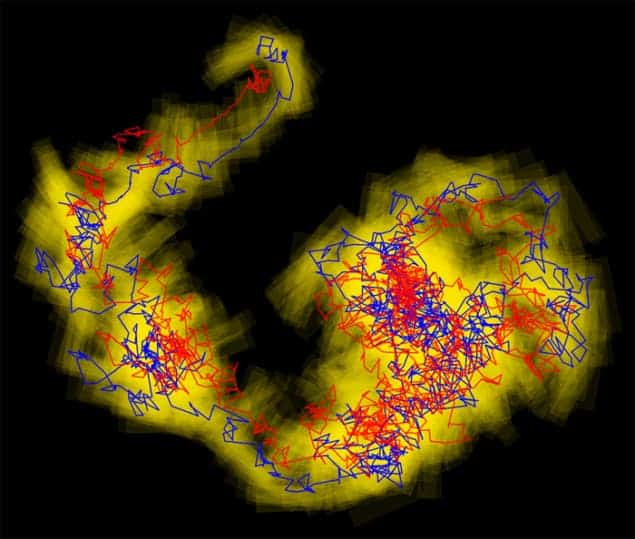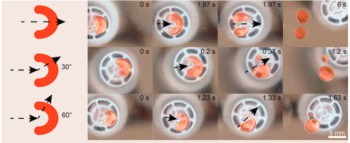
An international team of researchers has found that tiny boomerang-shaped colloidal particles suspended in a fluid move in a particular direction, for a short time. The team’s findings may increase our understanding of the diffusion of complex biomolecules and improve drug delivery techniques.
Brownian motion – first explained by Albert Einstein in 1905 – describes the random, erratic motion of tiny particles dispersed in a fluid, collectively called a colloid. It is caused by the many small “kicks” that are a result of the thermal motion of the fluid, where the particles are jostled in all directions with equal probability. This applies to spherical particles as well as ellipsoids – thanks to their overall symmetry – and the particles do not travel in any particular direction. Therefore, if the same particle starts from the same start point multiple times, it will follow a completely different, random path each time and the average displacement for all of these paths – the “mean displacement” – will be zero, as predicted by Einstein. This applies to both spherical and ellipsoidal particles.
Particular paths
Now however, Qi-Huo Wei and Jonathan Selinger of Kent State University in Ohio and colleagues have found that particles that are clearly non-spherical – such as a boomerang-shaped particle – do show a preferred direction of motion, at least initially. Wei told physicsworld.com that his group has had a long-term interest in using colloidal systems as models for mimicking atomic and molecular systems because their motion can be observed using optical microscopes. The group’s initial interest in boomerang-shaped colloidal particles was piqued thanks to “intriguing liquid-crystal phases exhibited by boomerang shaped molecular systems”, says Wei. Also, Selinger and his group at Kent State’s Liquid Crystal Institute have been working on theoretical descriptions of liquid crystals of boomerang-shaped molecules for a while, so it was “kind of natural that his group and my group team up for this project. Studying the Brownian motion of boomerang particles is the first step of our long-term objective”, says Wei.
Wei, Selinger and colleagues used photolithography – a method that uses ultraviolet light to make a pattern on a photoresist material – to make their polymeric boomerangs that are right-angled at the apex. Each boomerang arm is 2.1 μm long and 0.51 μm thick and the particles were suspended in water and trapped between two glass plates, confining their random movements to 2D.
The researchers then observed their Brownian motion using a video camera. “We have developed a high-precision image-processing algorithm to determine the position and orientation of a particle in each video frame,” says Wei. He explains that they analysed thousands of frames for each particle, amounting to over 150 videos of the motion trajectory of a single boomerang particle. “From that, we can calculate the mean particle displacements and the mean square displacements. So the experimental findings are obtained through extensive averaging,” explains Wei.
Random rotation
The video observations showed that for the first minute, each of the boomerangs moved in the direction of the line bisecting its arms – that is, their random movements occur in nearly the same direction each time and so they have a non-zero mean displacement. Then there is a transition to completely random movements only after about one minute – the time it takes the particle to rotate about 180°, according to Wei. After a minute the random impacts rotate the particle and it deviates from its initial path and its motion is completely random.
Apart from improving our understanding of how complex geometric shapes of particles affect their Brownian motion, Wei says that the new findings will allow us to better control the motion of such particles used in various applications.
Wei also points out research done by another group earlier this year, where it demonstrated that self-propelled particles with a shape similar to boomerangs can be made to move in circular trajectories. “One can imagine that, by using different geometric shapes, more complex trajectories can be designed, and such nanoswimmers may be useful someday, for example, for increasing the efficiencies of drug delivery,” he says. Other potential applications include new ways to sort and separate particles or biological macromolecules, based on their different geometric shapes.
The research is published in Physical Review Letters.



